
Europe and Mediterranean: Ultimate Mediterranean & Atlantic Passage Cruise
Holland America Line
A round-trip transatlantic cruise that grants every travel wish. Tour the Coliseum on a Rome overnight stay, explore Valletta's Old City, marvel at Egypt's Pyramids and so much more.

Executive Member Benefit
Executive Members receive an annual 2% Reward, up to $1,000, on qualified Costco Travel purchases
Digital Costco Shop Card
Member Exclusive: Digital Costco Shop Card with every Holland America Line sailing†
Sailing Itinerary

Note: Cruise itineraries are subject to change. Please verify ports and times directly with the cruise line.
Overview
New York City (officially the City of New York) is the largest city in the United States and one of the world's major global cities. Located in the state of New York, the city has a population of over 8.1 million within an area of 321 square miles (approximately 830 square km), making it the most densely populated major city in North America. Its metropolitan area has a population of 18.7 million and is one of the largest urban areas in the world. New York City is an international center for business, finance, fashion, medicine, entertainment, media, and culture, with an extraordinary collection of museums, galleries, performance venues, media outlets, international corporations, and financial markets. The city is also home to the headquarters of the United Nations, and to many of the world's most famous skyscrapers. Popularly known as the "Big Apple", the "City That Never Sleeps", or the "Capital of the World", the city attracts large numbers of immigrants, as well as people from all over the United States who come for its culture, diversity, fast-paced lifestyle, cosmopolitanism, and economic opportunity. The city is also currently distinguished for having the lowest crime rate among major American cities.
Overview
Ponta Delgada, capital of the Azores, is situated on the largest island, Sao Miguel, of the Azores. It has marvellous churches, some with fabulous Baroque interiors. Also palaces from the 17th and 18th centuries. Other places worth visiting are the Lagoa do Fogo and the village of Ribeira Grande, which has important architectonic features. Set within the confines of a wide inlet, Ponta Delgada is the tourist heart of São Miguel. Museums and monuments abound, and historic streets connect hotels, restaurants and shops. A marina harbours sailboats from Europe and America. And for those who enjoy entertainment after hours, the night brings with it a touch of animation.
Overview
Lisbon is Portugal’s hilly, coastal capital city. From imposing São Jorge Castle, the view encompasses the old city’s pastel-colored buildings, Tagus Estuary and Ponte 25 de Abril suspension bridge. Nearby, the National Azulejo Museum displays 5 centuries of decorative ceramic tiles. Just outside Lisbon is a string of Atlantic beaches, from Cascais to Estoril.
Overview
The capital of the region with a population of 168,000, Cartegena was founded, as its name suggests, by the Carthargenians in 227 BC and it became Hannibal’s capital city on the Iberian Peninsula. Today it is a modern, industrial city although relics of the its past are still highly visible. The narrow streets of the old town were built around the ruined 13th century cathedral. There are several sites of historical interest including the remains of the Roman road, an old Roman theatre and the Literna (an ancient lighthouse of Moorish origins). Cartagena’s ancient seaport and naval dockyard is where the first submarine was built in 1900 and where submarines are still built today. The port consists of a deep bay with a natural harbour, hence the town’s historical importance. Cartagena has a large shopping centre, plenty of supermarkets and other amenities you would expect to find in a large town including a hospital, schools and sports facilities. The town is the major service centre for the Costa Calida urbanizations that continue to develop around it. Cartegena is 30 minutes drive from Murcia via the N301 San Javier airport is 15km from Cartagena. The excellent golf courses at La Manga, which has 3 18-hole courses of international standard, are 20km away.
Overview
Barcelona is a charming, cosmopolitan port on the shores of the Mediterranean sea. This prosperous and bilingual (Spanish and Catalan) metropolis measures up to a city such as Madrid: its museums, theaters, art galleries and nightlife area of an impressive high standard. Besides that, this art and design centre has a lot of interesting sights to offer to its visitors. The best place to watch people go by, to stroll or simply relax, is 'Las Ramblas', a pedestrian street with dozens of outdoor cafes. Here, you’ll find flower-stands, book kiosks and small market stalls where they sell birds and small animals. You’ll also find an endlessly fascinating flowing receptacle of pageant-jugglers, singers, dancers, puppeteers, sidewalk artists, living statues and assorted oddballs on parade. Nearby is 'Plaça Real', with plenty of bars and restaurants, and 'Palau Guell', built by the Catalan architectural genius Antoni Gaudi in his undulating art-nouveau style. After having seen these sights, stroll the narrow winding streets of the 'Barri Gotic', the medieval Gothic quarter full of interesting tapas bars and cafes. Check out Picasso’s old hangout, 'Els Quatre Gats', which has been renovated without losing its bohemian charm. Or head for the old Barceloneta section on the waterfront. This working-class area, which was always slightly rundown and scruffy-looking, is now packed with paella restaurants. The new beach area, which runs from Barceloneta to the Olympic village, is much cleaner than the old beach area. Although some people believe that it has been cleaned up considerably, it might be a wise idea to stay out of the water. Fortunately, the beach itself is already a feast for the eyes (and ears), with its huge and roaring waves.
Overview
Livorno is situated along the coast of the Ligurian Sea, is one of Italy’s most important ports, both as a commercial and touristic port of call, an industrial centre of national importance and, among all of the Tuscan cities, it is generally considered the youngest, even though its territory holds historical testimonies of remote times that have survived the mass bombings of the Second War World. The city, developed from the end of the XVI century upon request of the Medici family, is famous for being the birthplace of prestigious personalities such as Amedeo Modigliani, Pietro Mascagni and Carlo Azeglio Ciampi. In the past, until the first years of the 20th century it was also a tourist destination of international importance for the presence of important seaside and thermal establishments, that give the city its the name of Montecatini-on-the-sea. Livorno, which at the end of the XIX century counted around 100,000 inhabitants and was the 11th most populated city in Italy and the 2nd in Tuscany, in the last decades has had a notable decline in the number of inhabitants and now is the 3rd most populated city in Tuscany after Florence and Prato.
Overview
Located about 80 kilometers northwest of Rome, the Port of Civitavecchia is the port of Rome and a busy ferry and cargo port serving Italy and southern Europe. Lying on Italy’s eastern shores on the Tyrrhenian Sea, the Port of Civitavecchia has excellent direct connections to Rome. It is an important cruise and ferry port with regular passage to Sardinia, Malta, Sicily, Tunis, and Barcelona. Fishing is of secondary importance to the Port of Civitavecchia. In addition to ocean-going traffic, the Port of Civitavecchia also contains a thermoelectric center and metallurgical works. In 2006, over 51 thousand people called the Port of Civitavecchia home. The Port of Civitavecchia was built on an earlier Etruscan settlement. Emperor Trajan founded the Port of Civitavecchia in the early 2nd Century, calling it Centumcellae. Today, Trajan’s Port is preserved within today’s Port of Civitavecchia. A busy growing town during the late Roman era, the Port of Civitavecchia was attacked by Vandals and then destroyed by the Saracens in 828 AD. Residents escaped to the nearby Allumiere Mountains where Pope Leo IV built a walled town in 854. Eventually, the people returned to Civitavecchia (the name means “old city”). At the end of the 15th Century, the Port of Civitavecchia was under frequent attack by pirates. The naval arsenal was constructed in 1508. Pope Paul III commissioned the building of the keep, which was designed by Donato Bramante and then finished by Michelangelo in 1537, to protect the Port of Civitavecchia from the pirate attacks. In 1696, Civitavecchia became a free port under Pope Innocent XII. Because it was Rome’s main port, the French occupied the Port of Civitavecchia in 1849. The Port of Civitavecchia was linked to Rome by the Rome and Civitavecchia Rail Road in 1859. When the Port of Civitavecchia became part of the Kingdom of Italy in 1870, it was one of the Papal State’s most strongly-fortified towns when Papal troops welcomed General Nino Bixio on behalf of the Italian unification forces into the Port of Civitavecchia fortress. World War II brought destruction to as much as three-quarters of the Port of Civitavecchia. Reconstruction enlarged the Port of Civitavecchia beyond its pre-war area. The Autorita Portuale Civitavecchia (Port of Rome) is responsible for managing and operating the Port of Civitavecchia as well as the ports of Fiumicino and Gaeta. The modern Port of Civitavecchia is at the center of rail, road, and air networks that link it with central Italy and the world. The Port of Civitavecchia has capacity to handle about 11 million tons of cargo per year and over 1.5 million passengers. Cargoes include forest products, cereals, iron and steel, chemicals, automobiles, containers, and liquid bulk. In 2007, the Port of Civitavecchia welcomed 856 cruise vessels carrying 1.6 million passengers, and the total number of passengers using ferries and cruise vessels was 3.8 million. In 2007, the Port of Civitavecchia handled a total of 7.7 million tons of cargo. This total included 1.5 million tons of liquid bulk, 1.7 million tons of solid bulk, 4.6 million tons of packages, and 31.1 thousand TEUs of containerized cargo. The Port of Civitavecchia contains 28 berths of a total 5.6 thousand meters in length with alongside depths from 6 to 18 meters. Port properties include five warehouses containing 36 thousand square meters for handling and storing cargoes. The intermodal terminal includes seven thousand square meters of storage space and 12.5 thousand square meters for loading/unloading rail cars and parking. The Port of Civitavecchia is one of the busiest ferry ports in the world. Just 80 kilometers northwest of Rome, it is the main tourist destination for people traveling to the Eternal City. It is also a central port for ferries carrying passengers to more local destinations. The ferry terminal offers a complete line of amenities. Different ferry companies offer services to the various destinations. Moby Lines handles crossings to Olbia, Sardinia. Corsica Sardinia Ferries runs services to Golfo Aranci. Grimaldi Ferries carries passengers to Barcelona and Tunis, and Grand Navi Veloci operates a route to Tunis. Ferrovie dello Stato operates a combined rail-ferry service to Golfo Aranci.
Overview
Located about 80 kilometers northwest of Rome, the Port of Civitavecchia is the port of Rome and a busy ferry and cargo port serving Italy and southern Europe. Lying on Italy’s eastern shores on the Tyrrhenian Sea, the Port of Civitavecchia has excellent direct connections to Rome. It is an important cruise and ferry port with regular passage to Sardinia, Malta, Sicily, Tunis, and Barcelona. Fishing is of secondary importance to the Port of Civitavecchia. In addition to ocean-going traffic, the Port of Civitavecchia also contains a thermoelectric center and metallurgical works. In 2006, over 51 thousand people called the Port of Civitavecchia home. The Port of Civitavecchia was built on an earlier Etruscan settlement. Emperor Trajan founded the Port of Civitavecchia in the early 2nd Century, calling it Centumcellae. Today, Trajan’s Port is preserved within today’s Port of Civitavecchia. A busy growing town during the late Roman era, the Port of Civitavecchia was attacked by Vandals and then destroyed by the Saracens in 828 AD. Residents escaped to the nearby Allumiere Mountains where Pope Leo IV built a walled town in 854. Eventually, the people returned to Civitavecchia (the name means “old city”). At the end of the 15th Century, the Port of Civitavecchia was under frequent attack by pirates. The naval arsenal was constructed in 1508. Pope Paul III commissioned the building of the keep, which was designed by Donato Bramante and then finished by Michelangelo in 1537, to protect the Port of Civitavecchia from the pirate attacks. In 1696, Civitavecchia became a free port under Pope Innocent XII. Because it was Rome’s main port, the French occupied the Port of Civitavecchia in 1849. The Port of Civitavecchia was linked to Rome by the Rome and Civitavecchia Rail Road in 1859. When the Port of Civitavecchia became part of the Kingdom of Italy in 1870, it was one of the Papal State’s most strongly-fortified towns when Papal troops welcomed General Nino Bixio on behalf of the Italian unification forces into the Port of Civitavecchia fortress. World War II brought destruction to as much as three-quarters of the Port of Civitavecchia. Reconstruction enlarged the Port of Civitavecchia beyond its pre-war area. The Autorita Portuale Civitavecchia (Port of Rome) is responsible for managing and operating the Port of Civitavecchia as well as the ports of Fiumicino and Gaeta. The modern Port of Civitavecchia is at the center of rail, road, and air networks that link it with central Italy and the world. The Port of Civitavecchia has capacity to handle about 11 million tons of cargo per year and over 1.5 million passengers. Cargoes include forest products, cereals, iron and steel, chemicals, automobiles, containers, and liquid bulk. In 2007, the Port of Civitavecchia welcomed 856 cruise vessels carrying 1.6 million passengers, and the total number of passengers using ferries and cruise vessels was 3.8 million. In 2007, the Port of Civitavecchia handled a total of 7.7 million tons of cargo. This total included 1.5 million tons of liquid bulk, 1.7 million tons of solid bulk, 4.6 million tons of packages, and 31.1 thousand TEUs of containerized cargo. The Port of Civitavecchia contains 28 berths of a total 5.6 thousand meters in length with alongside depths from 6 to 18 meters. Port properties include five warehouses containing 36 thousand square meters for handling and storing cargoes. The intermodal terminal includes seven thousand square meters of storage space and 12.5 thousand square meters for loading/unloading rail cars and parking. The Port of Civitavecchia is one of the busiest ferry ports in the world. Just 80 kilometers northwest of Rome, it is the main tourist destination for people traveling to the Eternal City. It is also a central port for ferries carrying passengers to more local destinations. The ferry terminal offers a complete line of amenities. Different ferry companies offer services to the various destinations. Moby Lines handles crossings to Olbia, Sardinia. Corsica Sardinia Ferries runs services to Golfo Aranci. Grimaldi Ferries carries passengers to Barcelona and Tunis, and Grand Navi Veloci operates a route to Tunis. Ferrovie dello Stato operates a combined rail-ferry service to Golfo Aranci.
Overview
Naples, a city in southern Italy, sits on the Bay of Naples. Nearby is Mount Vesuvius, the still-active volcano that destroyed nearby Roman town Pompeii. Dating to the 2nd millennium B.C., Naples has centuries of important art and architecture. The city's cathedral, the Duomo di San Gennaro, is filled with frescoes. Other major landmarks include the lavish Royal Palace and Castel Nuovo, a 13th-century castle.
Overview
Iraklion is the capital of Crete and of the prefecture of Iraklion. It is easily accessible from Athens by at least four flights a day. There are international flights from Iraklion to Frankfurt and to Amsterdam. Between April and October there are charters from many other European cities. Iraklion is a very busy city, especially during the tourist season, so it is advisable to book reservations for accommodation before arrival, especially during August. If you are travelling by car there are parking lots near the end of Kalokairinou Street at the Chanioporta and below the Archaeological Museum, one of the many uses of a medieval moat. Make use of them and take the opportunity to see the historical monuments. As you walk up 25 August (Odos 25 Avgoustou) Street you will see numerous agencies advertising tours of all kinds. Santorini, Rhodes, and Mikonos are some of the most visited islands. You can also arrange tours of Knossos, Festos, Gortyn, and the Samaria Gorge. Most of the offices are professional and offer good value. However, to avoid confusion and disappointment, pay attention to the details of the trip, such as: the time of pick up, time of arrival at site, time spent at site, and entrance fees; these may sometimes be vague. The National Road is easily reached from Iraklion. You can drive to Agios Nikolaos in 1 hr (72km) and Chania in 2 hours (137km). This road is enjoyable and the scenery is spectacular. Drive with caution on all roads in Crete. All means of transportation, including donkeys, farm equipment, and tour buses use the roads at varying speeds. These facts are not truly understood by many of the tourists, or even the locals. Iraklion is the fifth largest city in Greece and there has been a settlement here since Neolithic times. Although few remains have been found in the city proper, it was probably a port for Knossos during Minoan and Roman times. The Saracens captured it in 824 A.D. and renamed it El Khandak (The Moat) after the moat they dug around it. The city was regained by the Byzantine Empire in 961 A.D. after many unsuccessful attempts. After the Crusaders occupied Constantinople in 1204, they gave Crete to Boniface of Monferrat who sold the island to Venice for one thousand pieces of silver. Under Venetian rule the arts flourished and “Candia”, as the Venetians renamed it, became a centre of learning. Many scholars and artists took refuge in Candia after the fall of Constantinople in 1453. The Venetians began construction of the city walls in 1462, which were completed more than a century later. The walls were 4km in length, of a triangular shape and had seven bastions. The Venetians also built the harbour and various other masterly architectural works. The walls proved their deterrent strength when the city was besieged for 21 years, one of the longest sieges in history. The final surrender came in 1669 after 100,000 Turks and 30,000 Venetians had been killed. Turkish occupation was heavily resented by the Cretans and continuous guerrilla warfare was waged against the Turks and, in return, the Turks often made reprisals against the Cretan population in the cities. Iraklion grew in size after the 1913 union with Greece. However, its strategic location again made it a target for invading forces in 1941. The German bombardment during the Battle of Crete caused a great amount of damage and after the war the city was extensively rebuilt. Chania was originally the capital of Crete. The administrative centre of Crete was transferred to Iraklion in 1971.
Overview
The Mediterranean opens its arms widely to embrace its eternal bride (Alexandria) as she moves gracefully, while its waves splash on her rocks. All the world was a witness to this historical marriage contract about 2330 years ago. It was an illustrious wedding scented by history and concluded proudly under the auspices of Alexander the Great. The beginning of the idea was on the road to the Mediterranean coast when an isthmus dividing the Mediterranean from Lake Mariot attracted Alexander. Alexander pondered deeply about this site with its strange advantages that were suitable for the foundation of a great modern city in compliance with its period. Alexander's city was divided into five districts named after the first five letters of the Greek alphabet. From these districts, the Royal District occupied nearly one third of the whole area of the city and overlooked the Eastern Harbor. The Egyptians lived in the national district (Rhakotis) and the Jews lived in the 4th district known as the Delta, considered to have been the most important district in the ancient city. As for the main avenue - parallel to our present Nabi Daniel street - it was boarded from the north by the gate of the moon and from the south by the gate of the sun.
Overview
The Mediterranean opens its arms widely to embrace its eternal bride (Alexandria) as she moves gracefully, while its waves splash on her rocks. All the world was a witness to this historical marriage contract about 2330 years ago. It was an illustrious wedding scented by history and concluded proudly under the auspices of Alexander the Great. The beginning of the idea was on the road to the Mediterranean coast when an isthmus dividing the Mediterranean from Lake Mariot attracted Alexander. Alexander pondered deeply about this site with its strange advantages that were suitable for the foundation of a great modern city in compliance with its period. Alexander's city was divided into five districts named after the first five letters of the Greek alphabet. From these districts, the Royal District occupied nearly one third of the whole area of the city and overlooked the Eastern Harbor. The Egyptians lived in the national district (Rhakotis) and the Jews lived in the 4th district known as the Delta, considered to have been the most important district in the ancient city. As for the main avenue - parallel to our present Nabi Daniel street - it was boarded from the north by the gate of the moon and from the south by the gate of the sun.
Overview
Fira is a comparatively modern town, with houses built mostly during the 19th century when the old Venetian capital at Skaros became untenable due to earthquakes. The architecture is a jumble of Cycladic and Venetian, side by side, the similarities between the two being the stark whiteness. The impact of Aegean tourism has made itself felt in Fira, judging from the abundance of taverns, hotels, discotheques and shops. It is the largest town on the island and has gained preference with travelers because it is central and access to other parts of Santorini is made easy by either taxi or bus. From there you can indulge in some inspiring coastal walks. Wandering through the white cobbled streets of Fira, a town of about 2,000 inhabitants, one gets the feel of the old-world charm blended in with the modern day comforts. The town's archaeological museum is crammed with finds from excavations at Akrotiri. But besides being so interesting archaeologically, Santorini is essentially a beauty spot, an island whose cliffs seem to glow under an exceptionally clear light all day, but which at sunset glow redly, evoking that vast explosion more than 3000 years ago.
Overview
This seaside resort town has grown immensely in the last 30 years, and is especially popular with package holiday-makers from Europe. From a population of 6000 in the 1970s, it is now closer to 50,000, although a high proportion of this are part of the tourist industry and here only for the summer. Many cruising ships travelling around the Aegean Islands stop here, especially because of its close proximity (20km) to Selcuk. Kusadasi is a good base to explore this and other ancient cities like Priene and Didyma. Although there is little of historical interest in Kusadasi itself, the town is popular predominantly because of its many hotels, restaurants, souvenir and carpet shops, and lively nightlife. The Kale district has some old traditional houses and narrow streets, and gives some indication of what the town used to be like. The most famous beach is Kadinlar Plaji, 2.5km south of the town, dominated by huge hotels and can get very crowded in summer. There are several small beaches further south, and closer to town is Yilanci Burnu, the peninsular.
Overview
Istanbul is an international art and cultural center. The International Arts and Cultural Festival is held each year in June and July with famous artists coming from all over the world. These performances are held mostly at the Ataturk Cultural Center. Those who enjoy classical music can hear it at the Cemal Resit Rey Hall. Operas, operettas, ballets, films, concerts, exhibitions and conferences all contribute to the cultural palette of the city. Istanbul also has a rich program of light entertainment. Nightclubs provide splendid entertainment throughout dinner, ranging from a selection of Turkish songs to belly-dancing. Istanbul is a preffered city in terms of international art activities . This is because the art-lovers of Istanbul are respectful to the art and the artist. The famous performance artists feel themselves very comfortable in Istanbul concerts. Because the audience is very well aware of "the rituel of watching an artistic performance." The artist knows that he or she will not come across with impudent or disrespectful behavviours. It is the same for the international picture galleries, biennials, and visual activities. Neither the spectator nor the critic leave their "respectful attitude aganist the artist. " Hence the myths of traditional pop-rock genres, giants of jazz contempoporarylegends of classical western music are always in Istanbul, on the stage. To sum up; Istanbul is a city that can add compassion next to its giant size in terms of living area and population, and siling to assimilate the universal culture while "welcoming" it with utmost hospitality: a "world city" In this case, it deserves to be called "universal culture capital"
Overview
Istanbul is an international art and cultural center. The International Arts and Cultural Festival is held each year in June and July with famous artists coming from all over the world. These performances are held mostly at the Ataturk Cultural Center. Those who enjoy classical music can hear it at the Cemal Resit Rey Hall. Operas, operettas, ballets, films, concerts, exhibitions and conferences all contribute to the cultural palette of the city. Istanbul also has a rich program of light entertainment. Nightclubs provide splendid entertainment throughout dinner, ranging from a selection of Turkish songs to belly-dancing. Istanbul is a preffered city in terms of international art activities . This is because the art-lovers of Istanbul are respectful to the art and the artist. The famous performance artists feel themselves very comfortable in Istanbul concerts. Because the audience is very well aware of "the rituel of watching an artistic performance." The artist knows that he or she will not come across with impudent or disrespectful behavviours. It is the same for the international picture galleries, biennials, and visual activities. Neither the spectator nor the critic leave their "respectful attitude aganist the artist. " Hence the myths of traditional pop-rock genres, giants of jazz contempoporarylegends of classical western music are always in Istanbul, on the stage. To sum up; Istanbul is a city that can add compassion next to its giant size in terms of living area and population, and siling to assimilate the universal culture while "welcoming" it with utmost hospitality: a "world city" In this case, it deserves to be called "universal culture capital"
Overview
Today Piraeus is the home base of Greek shipping, the largest commercial fleet in the world, apace bound to the sea like few others. The harbours of Zea and Mikrolimano as well as Phaliro play host to countless yachts and sailing craft throughout the year. Piraeus was known in medieval times as Porto Leone, a name due to the enormous stone lion, which guarded the port's entrance. Today, the life of Piraeus is centred on its three ports: the main, central one and those of Zea and Mikrolimano. You can walk around the central harbour, shared by cargo and passenger ships alike, and watch the constant comings and goings of goods and people from around the world. Having completed your tour of the central harbour of Piraeus you will then head south traversing the peninsula and arrive at Peiraiki, one of the most picturesque neighbour hoods in the city. Here one finds the harbour of Zea, one of the largest marinas in the Mediterranean. If the night finds you in the area, you can try one of the many bars found nearby. You can continue your tour along the waterfront heading towards Kastella but a small deviation toward the city centre will be useful for then you can visit the verdant square of the municipal Theatre with cafeterias and shops of all kinds surrounding it. The magnificent building housing the Municipal Theatre as well as the Town Hall and the Library complete the picture presented by the main square in the city. Piraeus's little natural harbours are among its busiest and most touristy areas: Mikrolimano, Passalimani, Zea, Freatida and Hatzikiriakio. Countless seaside tavernas provide delicious seafood washed down with the uniquely Greek drink, ouzo. The fresh smell of the sea and the sounds made by the assortment of caiques, yachts and sailing ships, which are moored next to the tables, complete the enjoyment of the food Beyond the port, the most impressive spots are the hills of Profitis Ilias and Kastela with their neoclassical mansions and modern buildings which look as they are hanging over the sea.
Overview
If you've ever wondered what sort of prize you'd get for saving Europe, look no further than Valletta. Named after La Valette, the Grandmaster who masterminded Malta's successful stand against the Turkish siege of 1565, Valletta became the city of the Knights of the Order of St John and the seat of Malta's government. While travelling through the Mediterranean, Sir Walter Scott described Valletta as 'the city built by gentlemen for gentlemen'. Today it's a beautifully preserved 16th-century walled city, small enough to cover in a few hours without sweating too much in the Mediterranean sun. In fact, the streets were carefully laid out to channel cool breezes in from the harbour. Situated on the northeast coast of Malta, Valletta is the capital, and is built on the promontory of Mount Sciberras which juts out into the middle of a bay. This dissects the bay into two deep harbours: the Grand Harbour to the east and the Marsamxett to the west. Valletta is a rough rectangle at the tip of a peninsula on the coast, just a few hundred metres across in either direction and thus surrounded by water on its northern, eastern and southern sides. The city was named after Jean Parisot de la Valette who was the Grand Master of the Order of the Knight Hospitallers (Knights of Saint John of Jerusalem). This famed religious order of hospitallers was founded in Jerusalem in the 11th century and made their base in Malta after they were expelled from Rhodes by the Ottoman Turks. During the time of Grand Master La Valette, in 1565, the Knights and the Maltese managed to suppress a siege on the island by the forces of Süleyman the Magnificent, Sultan of the Ottoman Empire in what was to become known as one of history's greatest sieges. Following the siege, the building of the city began in the same year 1565 in order to create a base for the defence of the island. Although Grand Master La Valette managed to lay the first stone, he died before its completion. Most of the embellishments of Valletta were done during the time of Grand Master La Cassiere, especially the magnificent St John's Co-Cathedral. The reign of the Knights of St John eventually came to an end with the successful invasion by Napoleon who occupied Malta on his way to Egypt. A Maltese revolt against the French garrison was the catalyst for the occupation of Valletta by the British in 1800. Valetta is also the spot where the Italian fleet surrendered to the Allies in 1943. Valletta's network of streets is laid out in an orthogonal grid dominated by a main artery which crosses the length of the entire city and opens up into a series of squares at its geometric centre, around the Palace of the Grand Masters. The city architecture is inspired by Italian Renaissance planning principles, and served as an early model of urban design. Valletta is one of the most important planned towns of the Renaissance. It equals in its noble architecture, any capital in Europe, while its timeless beauty and artistic treasures make it a well-deserved World Heritage site. There are a number of superb museums here as well as historical sites that are worth visiting. The main thoroughfare in the city is Republic Street. You'll find all the main shops and character-filled side streets leading off from here. For those interested in shopping, Merchant's Street and Lucia Street are the places to go for the most interesting merchandise. Lucia Street is famous for the exquisite silver and gold filigree jewellery sold there. Merchant Street specializes in souvenirs and is also home to a large open market.
Overview
La Goulette is the port of Tunis, the capital of Tunisia. The Kasbah fortress was built in 1535 by Charles I of Spain but was captured by the Ottoman Turks in 1574.
Overview
The Sahara desert covers more than four-fifths of the land. Oil and gas reserves were discovered here in the 1950s, but most Algerians live along the northern coast. The country supplies large amounts of natural gas to Europe and energy exports are the backbone of the economy. Algeria was originally inhabited by Berbers until the Arabs conquered North Africa in the 7th century. Staying mainly in the mountainous regions, the Berbers resisted the spreading Arab influence, managing to preserve much of their language and culture. They make up some 30% of the population. Algeria's economy has suffered somewhat from the ravages of war so getting around can be a bit cumbersome. Travel in Algeria takes place mostly in the form of car and bus and the country can either be accessed by road or by air. Figuring out which method of transport to choose can be quite bothersome but car hire definitely gives you more room though it also makes you a bit of a target as it could lead to you getting lost or heading into dangerous territory unwittingly. However finding a place to stay is generally a whole lot easier with the reasonable number of hotels which dot the more tourist-friendly parts of the country.
Overview
Gibraltar is a British Overseas Territory and headland, on Spain's south coast. It’s dominated by the Rock of Gibraltar, a 426m-high limestone ridge. First settled by the Moors in the Middle Ages and later ruled by Spain, the outpost was ceded to the British in 1713. Layers of fortifications include the remains of a 14th-century Moorish Castle and the 18th century Great Siege Tunnels, which were expanded in WWII.
Overview
The city of Cadiz, which practically accounts for the whole of the municipal area, lies to the east of the bay of the same name, in an area which could be described as half island, half peninsula, connected to the mainland by a slender, sandy strip. Its situation is responsible for its obvious maritime tendencies, and it has been totally dedicated to seafaring pursuits since its foundation. The Phoenicians, Greeks, Romans and Arabs all passed through what is believed to be the western world’s oldest city, and it was here that Spain’s first democratic Constitution was drawn up. Despite its essentially urban nature, it also boasts areas of natural interest, such as the beaches of La Cortadura and El Chato, as well as Santibanez Mud Flats, which are part of Cadiz Bay Natural Park. The city, popularly known as “La Tacita de Plata” (The Silver Cup), has an unmistakable marine flavour, and its people are famous for their good humour and hospitality, as witnessed by the famous carnival; it boasts monuments of great interest, such as the Cathedral, the city walls, Holy Cross Parish Church, the Genoese Park, Puerta de la Caleta, etc. All places of indubitable charm, to which we must add the city’s cuisine and beaches, famous for their beauty, such as La Caleta, Santa Maria del Mar and La Victoria. History This legendary city was founded by the Phoenicians in 1100, although the oldest archaeological remains date back to around 800 B.C. Mythology links its foundation with Hercules and the legendary Tartessia. The Phoenicians called the city Gadir, meaning “closed area”. They built a commercial factory and a temple in honour of the god Melkart In 206 B.C. it was joined with Rome as an allied city under the name Gades. This was the start of one of the most prosperous periods in Cadiz’s history, and it became one of the most important cities in the Roman Empire. In the Imperial age, it was known as “Augusta Urbs Julia Gaditana”. Its inhabitants were soon granted Roman citizenship. When the Moslem invasions began in the 8th century, it provided the armies with significant support by facilitating their passage, though it soon suffered a decline in importance which would prevail until the Christian conquest and re-settlement at the hands of Alfonso X, known as The Wise, between 1260 and 1262. During the 15th century, the city’s economic activity was based essentially on sea commerce, particularly in North Africa. In 1493, the Catholic Monarchs made Cadiz Crown property; it had belonged to the Ponce de Leon estate since 1470. With the discovery of America, Cadiz’s rise to greatness began, culminating in the 18th century. Its natural conditions meant that whenever it was impossible for ships to berth in Seville, they could do so in Cadiz. In 1717, Seville’s Contracting House was moved to Cadiz, the monopoly of American trade travelling with it; however, this situation was short-lived, as the concession to trade with the New World was extended to twelve ports in 1778. The town centre was consolidated in the 18th and 19th centuries, when urban renovation was carried out and most of the monuments and buildings that we know today were built. La Isla del Leon, now San Fernando, was the setting for the earliest meetings of the famous Cadiz Cortes, general constituent assemblies set up to provide Spain with a Constitution during the war of independence. Fleeing from the French, the Government took refuge near Cadiz, the only stronghold that the French were unable to capture during the whole of the war. Between 1810 and 1811, Government assemblies took place in La Isla de Leon Theatre; in February 1811, the proximity of Napoleon’s troops forced them to move to San Felipe de Neri Church in Cadiz, returning once more to La Isla de Leon before finally making their definitive journey back to Madrid in 1813. After the war, the city continued at the vanguard of liberalism, with its support for Riego in 1820 and its leading role in the face of the French invasion in 1823. In a similar vein, Cadiz was at the forefront of the 1868 uprising. At the end of the 19th century, the city’s economic decline began. A series of events including the loss of the colonial market, culminating in the 1898 Disaster, and the African War, among others, ushered in a crisis that was to have grave consequences.
Overview
Funchal city is the capital and owes its name to the plant called "funcho". This plant existed in abundance in this area. Sweets are still made from this plant today. The category of city was granted by King Manuel I, on 21 August, 1508. It's a city of white rows of houses that climb up the hills, like an amphitheatre around a beautiful bay of blue sea. This architectonic distribution, due to the region's rugged and high terrain, covers itself with special beauty to bring in the New Year, since it makes it possible to put on a fireworks display of rare beauty and present a unique festive illumination for the season. Funchal's port is the entry door for many cruise ships as well as for the loading and unloading of goods shipped by sea. The city is divided into three principal areas: on the west side, we have the tourist area where we find most of the hotels; on the east side, the so-called "Zona Velha" or "Cidade Velha" (Old Zone or Old Town), where old constructions predominate, some of them having been transformed into typical restaurants; and the central part, where a great part of the commerce and characteristic monuments are found.
Overview
New York City (officially the City of New York) is the largest city in the United States and one of the world's major global cities. Located in the state of New York, the city has a population of over 8.1 million within an area of 321 square miles (approximately 830 square km), making it the most densely populated major city in North America. Its metropolitan area has a population of 18.7 million and is one of the largest urban areas in the world. New York City is an international center for business, finance, fashion, medicine, entertainment, media, and culture, with an extraordinary collection of museums, galleries, performance venues, media outlets, international corporations, and financial markets. The city is also home to the headquarters of the United Nations, and to many of the world's most famous skyscrapers. Popularly known as the "Big Apple", the "City That Never Sleeps", or the "Capital of the World", the city attracts large numbers of immigrants, as well as people from all over the United States who come for its culture, diversity, fast-paced lifestyle, cosmopolitanism, and economic opportunity. The city is also currently distinguished for having the lowest crime rate among major American cities.
Onboard the Volendam
Volendam
Year Built: 1999
Year Refurbished: 2014
Double Occupancy Capacity: 1432
The beautiful garden theme of Volendam is reflected in an artful floral motif throughout the ship's spacious public rooms and elegant staterooms. Flowers are found in abundance in floral fabrics and tapestries, as well as huge vases of fresh floral arrangements. Guests aboard Volendam enjoy wide teak decks, elegant dining rooms and spacious staterooms — many with private verandahs.
Activities & Services (included in cruise)
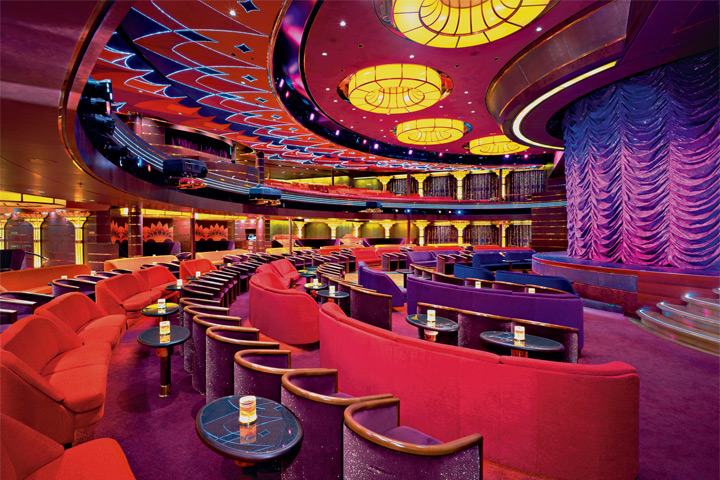
Show Lounge
- Card Room
- Casino
- Disco/Nightclub
- Movies
- Theater/Show Lounge
- Fitness Center
- Sauna/Steam Room
- Culinary Arts Center
- Educational Programs
- Pool - Outdoor
- Sports Facilities
- Whirlpool/Jacuzzi
- Art Gallery
- Bars/Lounges
- Library
- Children's Indoor Play Area
- Organized Age Specific Activities
- Teen Center or Disco
- Teen Programs
- Business Center
- Concierge Desk
- Duty-Free Shops/Boutiques
- Elevators
- Safe Deposit Boxes
Activities & Services (available for an extra fee)

Greenhouse Salon
- Beauty Salon
- Full-Service Spa
- Internet Center
- Babysitting
- Dry Cleaning/ Laundry Service
- Infirmary/Medical Center
- Self-Service Laundromat

Dining Room
Main Dining
The Dining Room: For breakfast, lunch or an unforgettable five-course dinner, the elegant main dining room is your destination for sophisticated dining, with menu selections from classic favorites to vegetarian options, to dishes inspired by the regions you’ll visit. Menus by Holland America Line's Culinary Council® of world-renowned chefs.
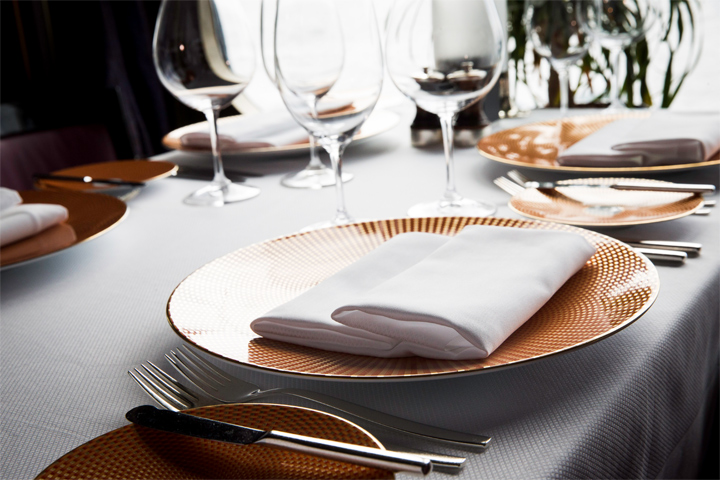
Pinnacle Grill
Specialty Dining
Pinnacle Grill: Enjoy dishes inspired by America’s Pacific Northwest, such as king salmon from Alaska and choice, responsibly raised beef from Washington State’s Double R Ranch. Complement your meal with a selection of boutique wines from the Pacific Northwest and other celebrated vineyards from around the world. This restaurant is available for an additional cost.
Canaletto: This authentic Italian restaurant offers a menu that celebrates spartire (Italian for "sharing"). Try braised chicken cacciatore "al forno," branzino ai ferri or a classic Italian pasta: spaghetti pomodoro or garlic shrimp-infused ravioli, perhaps. Buon appetito! This restaurant is available for an additional cost.
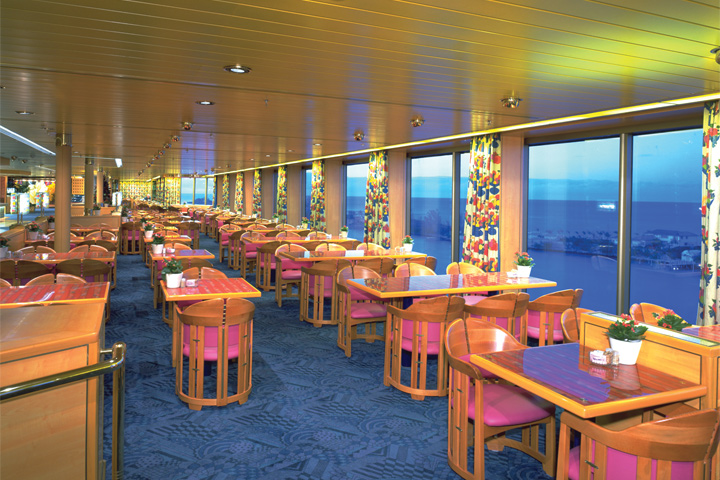
Lido Market
Casual Dining
Lido Market: Lido Market provides a fresh, new approach to casual dining for breakfast, lunch or dinner, with a panoramic view of the sea. A modern marketplace with different themed stations, the Lido offers a curated selection of delicious options to grab on the go or to have quickly made to order.
Dive-In: Dive in to a grilled burger on brioche or a Nathan’s Famous gourmet hot dog. For alfresco dining by the pool, Dive-In has it all, including lighter fare like the grilled chicken breast sandwich and vegetarian-friendly portabella mushroom stack.
Explorations Café: A comfortable, coffeehouse environment offering espresso drinks and pastries. This restaurant is available for an additional cost.
Room Service: Complimentary 24-hour dining in the comfort of your stateroom.
Staterooms feature premium massage showerheads, fine linens and fresh fruit upon request.
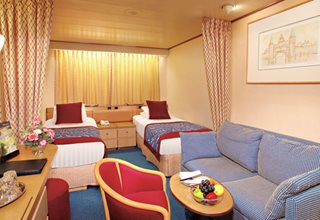
Category: N
Area: Approximately 182-293 sq. ft.

Category: MM
Area: Approximately 182-293 sq. ft.

Category: M
Area: Approximately 182-293 sq. ft.

Category: L
Area: Approximately 182-293 sq. ft.

Category: K
Area: Approximately 182-293 sq. ft.

Category: J
Area: Approximately 182-293 sq. ft.

Category: I
Area: "Approximately 182-293 sq. ft.
Elegant staterooms feature luxurious bedding, premium massage showerheads, a porthole or a window and fresh fruit upon request.
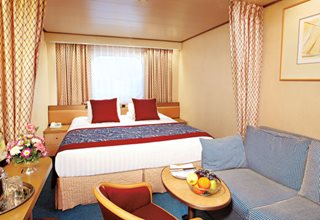
Category: HH
Area: Approximately 140-319 sq. ft.

Category: H
Area: Approximately 140-319 sq. ft.

Category: G
Area: Approximately 140-319 sq. ft.

Category: FF
Area: Approximately 140-319 sq. ft.

Category: F
Area: Approximately 140-319 sq. ft.

Category: EE
Area: Approximately 140-319 sq. ft.

Category: E
Area: Approximately 140-319 sq. ft.

Category: DD
Area: Approximately 140-319 sq. ft.

Category: DA
Area: Approximately 140-319 sq. ft.

Category: D
Area: Approximately 140-319 sq. ft.

Category: C
Area: Approximately 140-319 sq. ft.
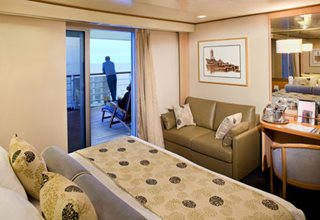
Category: CA
Area: Approximately 196-240 sq. ft.
Spacious staterooms have a private balcony, whirlpool bath (some with shower only) and more.
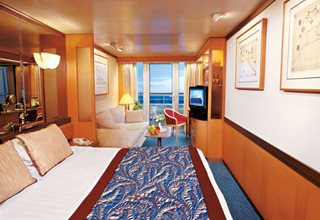
Category: BC
Area: Approximately 297-379 sq. ft. including verandah.

Category: BB
Area: Approximately 297-379 sq. ft. including verandah.

Category: B
Area: Approximately 297-379 sq. ft. including verandah.

Category: AA
Area: Approximately 297-379 sq. ft. including verandah.

Category: A
Area: Approximately 297-379 sq. ft. including verandah.
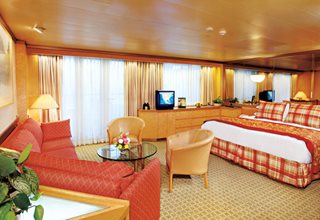
Category: SA

Category: SB

Category: PS
Area: Approximately 1,296 sq. ft. including verandah.
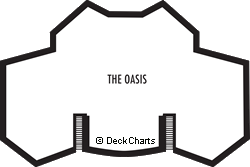
| Symbol | Description |
|---|---|
 | Shower only |
 | Bathtub & shower |
 | 2 lower beds convert to 1 queen-size bed (no sofa bed) |
 | Triple (2 lower beds, 1 sofa bed) |
 | Quad (2 lower beds, 1 sofa bed, 1 upper) |
 | Partial sea view |
 | These staterooms have portholes instead of windows |
 | 2 lower beds not convertible to a queen-size bed |
 | Fully obstructed view |
 | Suites B7088, B7087, B6228, and B6225 and stateroom EE3429 are fully accessible, roll-in shower only |
 | Suite SA7034 is fully accessible with single side approach to the bed, bathtub, and roll-in shower; Staterooms DA6104, G1805, and G1804 are fully accessible with single side approach to the bed, roll-in shower only |
 | Staterooms EE3396, EE3391, HH3431, HH3430, E2702, L2700, J2555, J2554, G2500, FF1964, FF1955, G1807, and G1806 are ambulatory accessible, roll-in shower only |
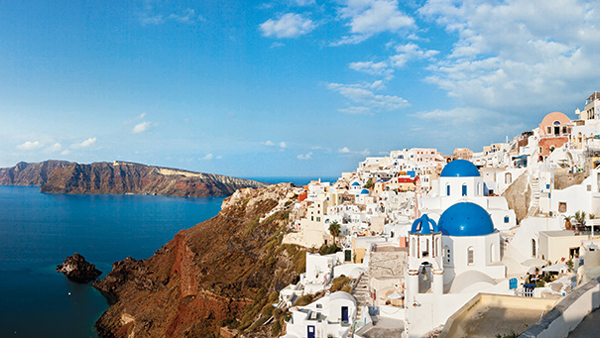
- Ship Name: Volendam
- Year Built: 1999
- Year Refurbished: 2014
- Year Entered Present Fleet: 1999
- Ship Class: R
- Maximum Capacity: 1,837
- Number of Passenger Decks: 10
- Number of Crew: 615
- Officers' Nationality: International
- Ocean-View without Balcony: 385
- Total Inside Staterooms: 134
- Tonnage (GRT): 61,214
- Capacity Based on Double Occupancy: 1,432
- Country of Registry: Netherlands
- Total Staterooms: 716
- Suites with Balcony: 197
- Crew/Hotel Staff Nationality: International
Available Dates & Prices
Terms & Conditions
*Price shown is per person based on double occupancy and is valid for select stateroom categories only. Click on the Terms & Conditions link below for details.
†One Digital Costco Shop Card per room/stateroom, per stay. The exact amount of the Digital Costco Shop Card will be calculated during the booking process. The Digital Costco Shop Card promotion is nontransferable and may not be combined with any other promotion. A Digital Costco Shop Card will arrive by email approximately 10 days after the start of your cruise. Click on the Terms & Conditions link below for additional information.
Ship's registry: The Netherlands
Digital Costco Shop Card
This booking includes a Digital Costco Shop Card which will arrive by email one to two weeks after you return from your vacation. The Digital Costco Shop Card is a convenient payment option in our warehouses and on Costco.com.




























